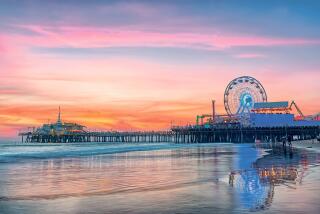Living in L.A.âs world of guns
I grew up in South Los Angeles at a time and in a neighborhood where, even for a child, having a gun pointed at you happened.
For me, the first time was when I was 12 years old. Iâd gone around the corner to visit a friend and a pretty new girl who had recently moved in next door to him. We were roughhousing, and somehow the girl fell and hit her head. She stood and accused me of deliberating hurting her; then she left. Before I could decide what to do, she had returned with a gun, which she pointed at me.
âYou hurt me,â she said, tears running down her cheeks. âAnd Iâm going to shoot you for it!â
SLIDESHOW: The 10 trigger-happiest states in America
Though I was rooted to that spot with fear, I surprised myself by saying very calmly that I was sorry if Iâd hurt her, and that I hadnât meant to. I told her Iâd leave, and sheâd never see me again, so she shouldnât waste the bullet. I slowly backed away, feeling that Iâd talked myself out of being shot. I knew Iâd been lucky, and I hoped I would never be in that situation again.
It was a vain hope.
My next encounter with a gun was unsettling, but I think it wasnât intended to be serious. Some guys I almost regarded as friends stopped me at shotgun point and said that it was a jack, a robbery, and to give up whatever I had. I complied with a shrug, thinking maybe they were kidding, and produced from my pocket two large, red, translucent dice that my mother had bought for me on a recent trip to Las Vegas. The guys laughed, put the shotgun away and headed off to continue their dangerous adventure.
The time after that my high school girlfriendâs drunken stepfather aimed a double-barreled shotgun at me at close range after seeing me hug his stepdaughter while she made French fries for the family. She grabbed the gun from him. Only later did she tell me they had already taken the precaution of hiding the shells.
I accepted these and other encounters with guns as what happened in my neighborhood, even to kids like me who stayed on the right side of the line, the ones who didnât drink, didnât get high and were college-bound.
At UC Santa Barbara, where I went to college, the only time I saw a gun was when the Isla Vista police approached me, and that gun was at least holstered. But then I returned to Los Angeles to teach at Locke High, and I was back in the world of guns. I took over a class for a teacher who had threatened his students with a 9mm pistol. During my time at Locke, one student was shot in the face and left to die at a phone booth, and another was shot for a leather jacket she wouldnât give up.
I married and went to graduate school and started a family in Pasadena. We sent our kids to private schools and moved to a gated community, determined to isolate our girls from stray bullets. But then, when our 18-year-old was about ready to leave for college, she told me in passing that at a party in Pasadena, on a nice street with impressive houses, someone had fired a gun and the partygoers stampeded. She described how she and her friend had fled, but unwittingly found themselves in a dead-end alley where they hid until the shooting stopped.
I was grateful that she told me what had happened, even if it was days after the fact. I canât say I was shocked; it was too familiar for that. But I was profoundly relieved that my beautiful and bright daughter wasnât wounded or taken from us by a bullet fired out of drunken rage or insanity.
Certainly itâs statistically true that wealth and education protect one from the small-scale weapons of war that terrorize our society, but even so, those protections arenât magic talismans. The brutal and flawed logic of 2nd Amendment absolutists affects all, endangers us all and can rob our children of everything.
Jervey Tervalon is the director and founder of the Literature for Life project. His latest novel is âServing Monster.â
More to Read
A cure for the common opinion
Get thought-provoking perspectives with our weekly newsletter.
You may occasionally receive promotional content from the Los Angeles Times.










